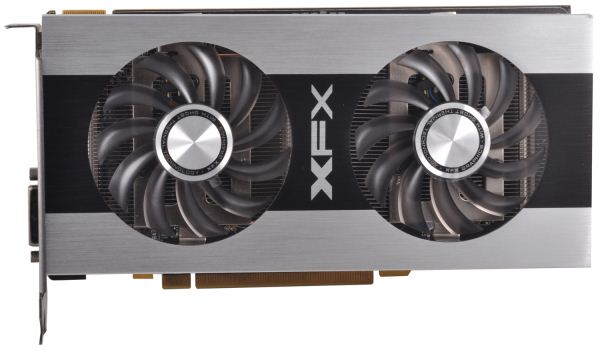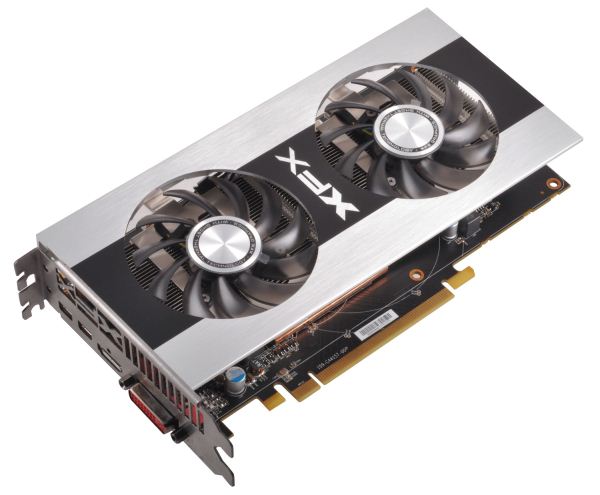AMD Radeon HD 7750 & Radeon HD 7770 GHz Edition Review: Evading The Price/Performance Curve
by Ryan Smith & Ganesh T S on February 15, 2012 12:01 AM EST- Posted in
- GPUs
- AMD
- HTPC
- GCN
- Radeon HD 7000
Meet the XFX R7770 Black Edition S Double Dissipation
Our final card of the day is XFX’s R7770 Black Edition S Double Dissipation, one of a multitude of Radeon HD 7770 cards XFX will be releasing today. XFX will be releasing two factory overclocked Black Edition cards today, with the S edition BESDD being the higher clocked of the two. It will be clocked at 1120MHz core and 5.2GHz memory, which is a 120MHz (12%) core overclock and 700MHz (15%) memory overclock compared to the reference 7770.
Like all the other 7770s being released today XFX is using the AMD reference PCB for the BESDD, so XFX is primarily relying on their factory overclock and their custom cooler to stand apart from AMD’s other partners. To that end the BESDD is very similar to the other XFX Double Dissipation cards we’ve reviewed in the last month. A copper plate sits at the base of the cooler, transferring heat to an aluminum heatsink that runs virtually the entire length of the card. Above that sits a pair of fans and then finally the metal shroud that covers the card.
Overall the design is similar to a number of other dual fan cards we’ve seen in the past, and as we’ll see in our benchmarks the resulting cooling is quite effective. In terms of quality however I feel XFX has missed the mark – the cooler is only attached to the PCB around the GPU, so at 8.25” long there’s nothing retaining the PCB at the far end to keep it from flexing. A stiffener would have been a great idea here, which is something XFX does on the 7900 series. Furthermore in the case of our sample the construction quality was also subpar, as the screws responsible for securing the metal shroud were not properly tightened and thereby leaving the shroud loose. This is nothing 30 seconds with a screwdriver couldn’t fix and I don’t have any reason to believe this is a common problem, but it’s a quality control issue none the less.
As the BESDD uses AMD’s 7770 PCB, the length of the card and display connectivity is identical. The card measures 8.25” long with no cooler overhang, while display connectivity is provided by 1 DL-DVI port, 1 HDMI port, and a pair of miniDP ports.
Rounding out the package is the same collection of extras that we saw in the 7950 BEDD. Inside you’ll find the usual driver CD and quick start guide, along with a metal XFX case badge, a mid-length CrossFire bridge, a DVI to VGA adaptor, and a passive HDMI to SL-DVI adaptor. All of this is packed in one of XFX’s pleasantly small boxes, which doesn’t use much more space than the card itself.
The MSRP on the R7770 BESDD is $184, $25 over the MSRP for a regular 7700 and pushing it well into the territory of the Radeon HD 6870 and GeForce GTX 560. XFX is offering a base 2 year warranty on the R7770 BESDD, which can be extended to a lifetime warranty by registering the card within 30 days of purchasing it.












155 Comments
View All Comments
Dianoda - Wednesday, February 15, 2012 - link
Yeah, I jumped on that BB/Visiontek HD4850 512MB deal as well. Bought the card about a week before the official launch and at a $50 discount on top of that. Timing was perfect, too, as I had just finished my build, short one video card (borrowed a 3850 from a friend for a few weeks).I finally upgraded from that card to a 6950 2GB (BIOS modded to 6970) about a month ago - Skyrim was just too much for the 4850 to handle @ 2560x1440. The 6950 2GB is a great card for the price if you're willing to perform the BIOS mod (and don't mind rebate forms).
nerrawg - Thursday, February 16, 2012 - link
Exactly! I bought 2 4850's in the UK in 2009 for £65 ($95) each - best GPU purchase I have made in 12 years! I now have a single 6870 that I bought in 2011 for £120- but its not really an upgrade at all. Thought I would wait and get a second one cheaper but now I don't think that will happen2008-2009 was the sweet spot of a decade for Desktop GPUs. The way things are going with the Desktop (AMD bullsnoozer etc. etc.) I fear that it might have even been the sweet spot of GPU performance for the decade to come as well. I would love to see some massive progress in graphics, but it seems that the all the "suites" care about now days is "smart" this and "smart" that. I can't really blame them either, because until pc programmers get their act together and actually start making apps and games that push what is possible on current hardware I don't see any reason why I need 2X the GPU and CPU compute power every 1-2 years.
Come on guys - we are all waiting for the next "Crysis" - if it doesn't come then it might spell the end of the enthusiast desktop
StrangerGuy - Wednesday, February 15, 2012 - link
AMD having a fail product at $160 that couldn't even beat an almost 1.5 year old $150 6870 isn't surprising considering they are also the ones with the cheek to price their FX-8150 at near 2600K prices.thunderising - Wednesday, February 15, 2012 - link
The only problem I have with AMD on this card is WHY THE LOW BANDWIDTH.The card performs nearly 10% faster when the memory is clocked at 6GHz QDR (TPU reviews) and 15% with Core Clock matching XFX's OCed Speed.
I think that 6GHz memory modules would have taken the HD7770 a long way ahead. The performance boost would have been enough to hit HD6850 performance, or beat it in all cases, and at that point, this card at 159$ would make sense.
Right now, until the price hits about 129$, this doesn't make sense.
chizow - Wednesday, February 15, 2012 - link
But you get GCN, 28nm and a bottle of verdetard?Zoomer - Wednesday, February 15, 2012 - link
GCN is worse than useless for gamers and non compute users.jokeyrhyme - Wednesday, February 15, 2012 - link
I think I've built my last system with an AMD CPU. Intel completely abused their monopoly and decimated AMD's success in the CPU department, and I don't think AMD will have an enthusiast-quality CPU ever again. :(That said, I think I will still use AMD GPUs for a while yet.
nVidia's Kepler may beat AMD later this year, but AMD actually has an open-source driver developer on staff and routinely publishes hardware documentation. AMD GPUs will probably have better support for Wayland than their nVidia counterparts due to these factors. If you use Linux and want to stay on the cutting edge, then I don't think picking nVidia is particularly wise.
ganeshts - Wednesday, February 15, 2012 - link
At least in the HTPC area, NVIDIA is miles ahead of AMD in the open source support department.Almost all Linux HTPCs capable of HD playback have NVIDIA GPUs under the hood, thanks to their well supported VDPAU feature.
AMD started getting serious with xvBA only towards the end of last year, and they still have a lot of catching up to do [ http://phoronix.com/forums/showthread.php?65688-XB... ]
Ananke - Wednesday, February 15, 2012 - link
AMD is several years behind NVidia on the compute side...actually they are nowhere as of today. The AMD 7xxx series is so ridiculously priced, it will not get an user base to be attractive for developers. Actually, I am at the point of considering NVidia cards for computing, despite that I hate their heat and power consumption.AMD had their chance and they blew it.
Besides, we shall see where the AMD ex-VP will go - that company most likely will be the next big player in graphics and high performance computing. Probably Apple.
PeskyLittleDoggy - Thursday, February 16, 2012 - link
In my country, company policy dictates you cannot leave your company and work for a competing company if you have valuable R&D knowledge. Thats part of the restraint of trade clause in your contract.Basically what I'm saying is, AMD's ex-VP will not be able to work in any company with a graphics department for 2 years if the contract is similar to mine. I can't remember now but some CEO was sued for that recently.